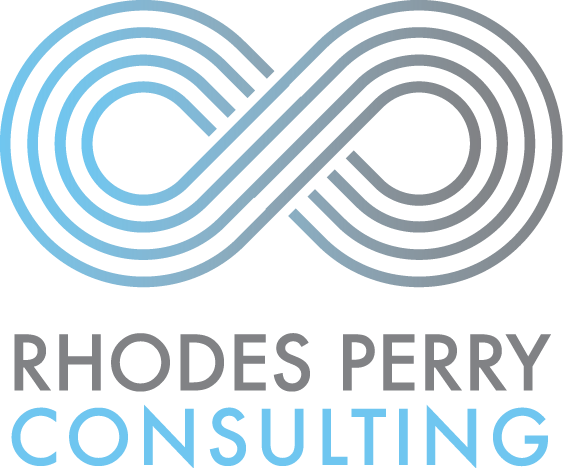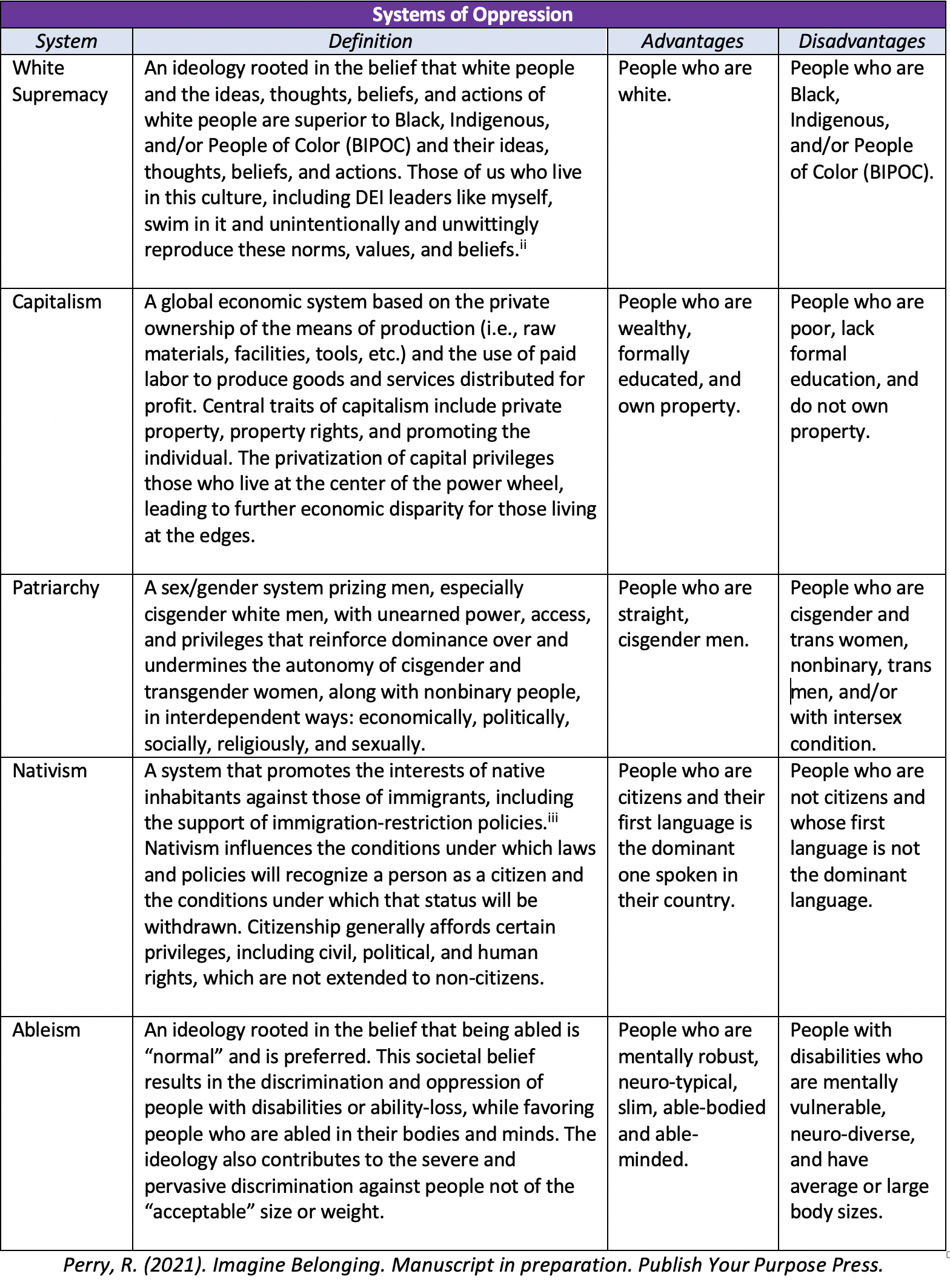How can you confront systems of oppression?
The longer you swim in a culture, the more invisible it becomes.
- Kenneth Jones & Tema Okun
Systems of oppression – things like white supremacy culture, patriarchy, capitalism, ableism, and nativism (to name only a few), are pervasive. When it comes to the workplace, they create barriers to feeling a true sense of safety, trust, and belonging. Yet, they remain difficult to pin down, largely because they are fixtures of our culture, and as Kenneth Jones & Tema Okun have noted, the longer you are immersed in a particular culture, the more likely it will become invisible to you.
One powerful tool that shapes, reflects, and maintains systems of power in our culture is language. One literary practice that maintains the pervasive systems of power in our culture is euphemism. Euphemism refers to figurative language intended to replace words and phrases that would otherwise seem harsh, impolite or unpleasant.
In the 50th anniversary edition of Pedagogy of the Oppressed, Donaldo Macedo’s introductory comments offer some additional insights as to why the use of euphemistic language makes it so very difficult to name these systems of oppression that are fixtures in the dominant cultures of our workplaces and beyond:
Euphemism is a form of language that not only mystifies and distorts reality; it is also a much-used technique by dominant forces (the media, political pundits, the educated class) to distract attention from the real issues that ail society, such as the obscene widening of the income gap between the rich and the poor, the pernicious shrinking of the middle-class, and the generalized alienation of the dispossessed.
Oftentimes, workplace statements addressing current events connected to DEI commitments and the workforce use euphemistic language. These kinds of statements have ranged from denouncing the police murder of George Floyd, the spike in anti-AAPI hate crimes, the attempted ban on transgender people in the military, and the separation of children from their families at the U.S. and Mexican border. Most organizations stop short of issuing statements by failing to name the dominant power systems that incubated these injustices. These euphemistic statements prioritize the comfort of those of us who hold the greatest amount of power and privilege over the safety of those furthest removed from leadership decision-making positions.
When effectively written, organizational statements have the power to educate employees about current events. They have the power to acknowledge the feelings and harms current events may have on their employees – employees who are connected to the violence impacting BIPOC communities, employees concerned about the safety of their transgender child, or employees who may be undocumented and fearful of losing their jobs and being deported. They can also demonstrate a leadership team’s sincere commitment to building a workplace that values each of these employees and allays their fears, worries, and concerns.
Identifying Systems of Oppression
Before we can confront systems of oppression, we must first identify them. While this may sound simple on the surface, in reality it becomes much more challenging because we swim in a culture that renders these oppressive forces as invisible. This holds true in particular for those of us – myself included - that benefit from the unearned power and privilege these systems bestow. Many of us who receive unearned advantage from these systems may struggle with recognizing the ubiquitous inequities they embed into our workplace, and our lives.
Thanks to the scholarship of sociologists, economists, historians, and psychologists, we have a better understanding of where some of these systems of power manifest, and who likely benefits from them, as well as who doesn’t. The figure below offers a glimpse of some of these systems of oppression, or as bell hooks refers to them, as “interlocking systems of dominance.”
As you review the following systems of oppression, consider your own experience in the workplace. How have these systems impacted you on a personal level? How have they impacted your organization’s DEI goals? How might you use your relative power and privilege to confront these systems?
Important to note - these systems don’t have a hierarchy, or a particular order of severity. Just like the wheel of power explored in this blog post, these systems are the sum of our total culture. They are pervasive and ever present. Each system operates in an interdependent manner and, given this reality, we can’t view power and its influence on our workplace culture through a single system of oppression. Rather, we must become familiar as to how these systems collectively impact us, our teams, and our organizations so that we can steer our workplace’s culture toward more equitable systems that foster belonging. These equitable systems are meant to fully honor each of us, our talents, and the lived experiences we bring to our work.
Systems of Oppression & Your DEI Goals
Systems of oppression will derail your organization’s DEI commitments, if your leadership team lacks the awareness of their presence, or if they fear consciously naming their traits. For many of us, our organizations may champion a diverse workforce; however, if women are constantly interrupted by men, if BIPOC people are continually overlooked for promotions, if accommodations aren’t made for people with disabilities, if someone’s name is regularly mispronounced, if a person is consistently misgendered, if we can’t share more about our family and communities, then our stated commitments and good intentions hold very little promise of making the transformative changes many of us desire.
The research is clear – decades of evidence prove that diverse organizations where employees experience a strong sense of psychological safety and trust are more likely to experience business success and even industry breakthroughs. Yet failing to name and confront the harms caused by systems of oppression leads to an implicit culture that results in homogenous organizations where the same types of people produce the same types of products and services, leaving us with status quo institutions and stagnation of new ideas. Many working inside these systems are compelled to contort and/or cover the aspects of their identities that are most precious to them to conform to this status quo. As a result, they feel further excluded and disengaged from their work.
Systems of oppression limit our collective full expression in the workplace. These systems present themselves as the expected ways we are supposed to show up in our work. They pressure us to assimilate to the dominant culture, and they discourage us to show up as authentically as we want on the job for fear of negative consequences like losing our jobs. Regardless of how much positional power we may have accumulated on the job, dominant culture systems compel us to conserve our personal power, they coerce us to go along to get along, and they convince us that competing for scarce resources like money and power is the only way to organize our work.
Your Work
Review the systems of oppression listed above. Does this list feel complete? If not, what is missing from your perspective and lived experience? If you were to name another system of oppression here, how would you define it? Who receives unearned advantages from this system, and who experiences oppression, marginalization, or exploitation? How does it interlock with the named systems of dominance in this blog post? How does this system impact you? Do some of these feel uncomfortable or challenging to confront? And if so, why?
As you reflect on these questions, be sure to read through this blog post to identify the aspects of your identity in terms of where you hold more power and privilege, and where you don’t. Once you name these social identities, how do the systems of oppression impact you? How does this impact influence your feelings – or lack thereof – of safety, trust, and belonging at work? Does anything surprise you from doing this activity?
Now, consider your workplace’s DEI goals. How do these systems of oppression hinder the stated commitments your leadership team has agreed to advance? How might you begin to name these systems, and discuss their impacts on the work you may find yourself leading or supporting? Once identified, how might you and your organization begin to confront them? What might be one action you can take to get started? What about this action, or this entire activity, feels within reach? What feels too risky?
Remember, engaging in this identification work is challenging for a reason. While culture may feel like a fixed condition that can never alter, it does indeed change over time. Those of us aware of how it operates, and how it benefits or harms us, are best prepared to influence it. For DEI leaders, and those that support our work, practicing this kind of naming is an essential skill to help steer our organizations toward greater equity to build an emotional outcome of belonging.
***


